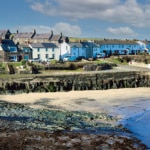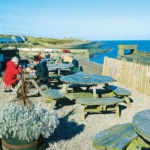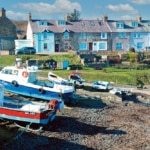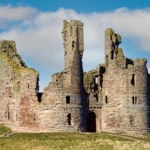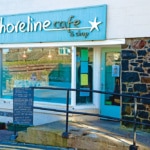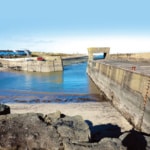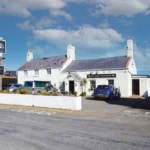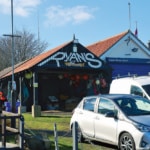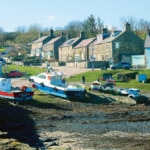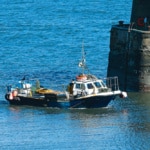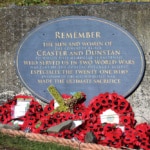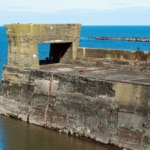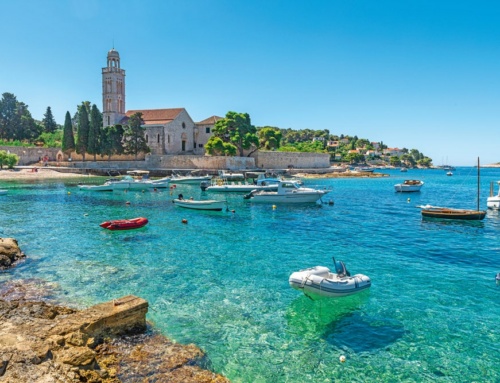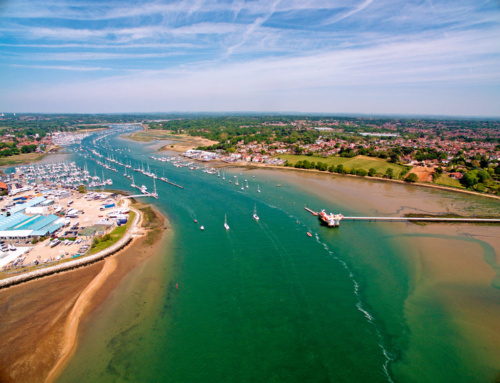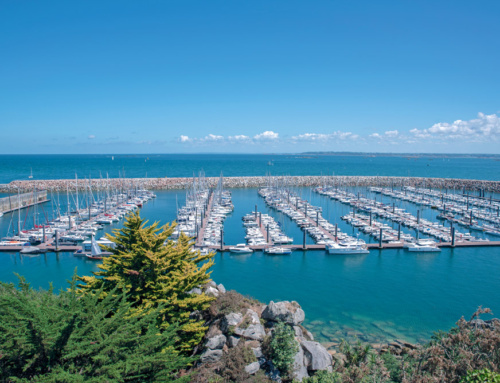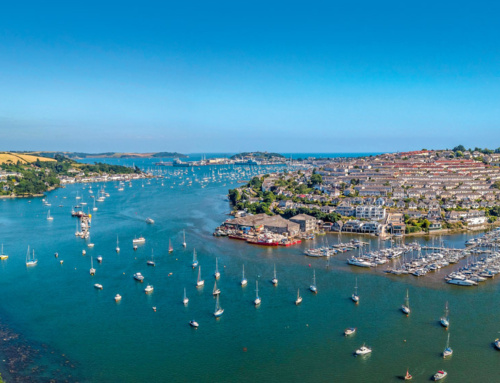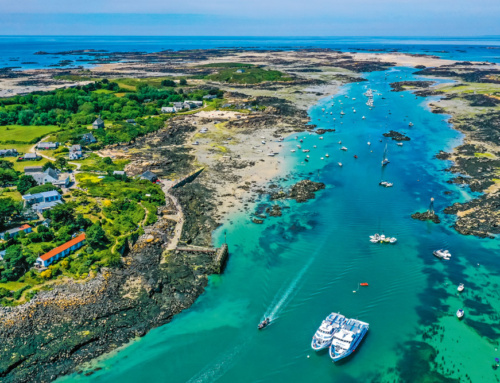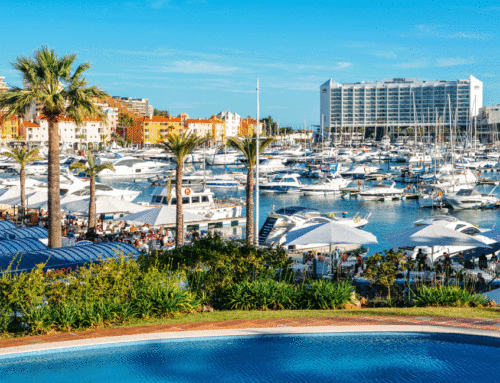Craster is a compact fishing village overlooked by a dramatic medieval castle. PBR head north in search of the idyllic …
The wild Northumberland coast has many hidden gems, and compact Craster is definitely one of them. Craster lies 55.28’.44N 001.35’.21W. Before the harbour walls were built in 1904, the only protection afforded was from the two inshore rocky shoals of Little Carr and Muckle Carr. From sea, Craster must be approached directly from the east, passing between the two carrs. To tell them apart, Little Carr’s rocky comb (to the north) is marked by a small concrete beacon. In any event, approaching Craster should be avoided in brisk onshore winds. However, in fine settled weather, Craster is a useful (but brief) top-of-the tide pause on a Northumberland coastal passage. Local boaters do not consider Craster a place to lay over on a coastal trip. They also report that at low water there is about 3 metres off the harbour entrance, with the harbour drying progressively within
Harbour history
Craster’s harbour is set behind substantial concrete ramparts. Originally a fishing village famous for its kippers and later a quarry port, the first thing to notice is a strange box-like structure on the harbour’s southern pier. It looks like a WWII installation but is actually much earlier. It was built in Edwardian times to provide the base for a much larger structure: an overhead ropeway. This ropeway brought the whinstone down from the town quarry, thence to be loaded onto ships in the harbour – a very impressive bit of industrial engineering, sadly now gone.
- The old harbourmaster’s house is now a holiday let.
- The Jolly Fisherman’s terrace has panoramic aerial views.
- Local boats hauled up on the foreshore.
In its heyday, Craster would have been a very busy place. As we walked around the harbour we noticed a small but obviously local monument to all those who served in both world wars. The concrete block to which the plaque was fastened had formed part of Craster’s defences in WWII. The fact that it was a modest but beautifully kept community commemoration said it all. The simplicity and local pride made it all the more touching. Another item spotted was a wonderfully weathered auld winch, which we guessed had been used to haul the old fishing boats up onto the strand. Today, there were a few fishing boats drawn up on the hard in the sunshine, scattered randomly here and there. Somehow they looked in exactly the right place, backed by a row of fishermen’s cottages. On a sunny day, Craster has its own authentic vibe. Despite the weathered concrete quays, plus all the harbour’s industrial antecedents, Craster casts its own sleepy spell. It is a surprisingly calm and soothing place to be.
Charts

Wonder how many boats this has winched up the hard …
Admiralty Chart 156 covers the broader area, but we could not find any specific Craster charts. However, the Navionics app on your smartphone, coupled with a good gander at Google Earth’s satellite images, makes the position of the off-lying rocky ledges pretty clear. Local advice when coming from the east is to aim straight between the gap in the two harbour walls. It looks a surprisingly small gap from seaward and feels a bit like stepping through two curtains; however, it was easy enough for powerboats like ours.
Tides
Local high tide occurs at Dover +0350.
Slipway
Craster has a slipway with modest launch and overnight fees. These are currently £10 to launch and £10 for an overnight stop – great value for money!
Fresh water
There is no fresh water available on the harbour piers, but if you search it out, there is a freshwater tap just over the road from the harbour – too far away for our longest hosepipe, mind!
Public toilets and parking
These are situated in the car park in an old quarry on the right-hand side as you first come to the village. Since there are no public toilets beyond, this is your last comfort stop.
Top tip:
Day tickets via a machine for parking at Craster are an acceptable £7 (payable by card, but avoid the proffered but time-consuming phone app download). As a bonus, such day tickets are valid for the same day all the way to Seahouses, and even as far north as Lindisfarne.
Dunstanburgh Castle
Many people come to Craster to visit the nearby Dunstanburgh Castle. Like a number of other villages and fortifications up this otherwise remote coast, the village and the castle certainly share a symbiotic relationship. The castle is clearly visible from the village and harbour – an amazing vista that looks tantalisingly close. Be advised, though, that Dunstanburgh is actually 1.3 miles away across the fields. Most significantly for families, there are no public toilets at the castle site. Neither is there a bus, a fleet of electric golf buggies or indeed any handy herd of donkeys. You have to hoof it over grass fields that slope parallel to the beach. But it is worth it as the views surpass expectation. On a fine day, the castle almost floats above the sands. On a bad day, its presence is enigmatically brooding and stark. However, although the castle may be only 1.3 miles away, in a headwind it is a bit of a march, which we judged unsuitable for a crew with restricted mobility. There are slopes and ramps, gates to open and close, and sheep gates to negotiate. Now, it so happens that our crew are used to serious castles (being English missionaries living in Wales); however, Dunstanburgh is on a different plane. Its exotic ruination is achingly romantic, and impossibly scenic. Almost unreal in the spring daylight, set just above its rocky ledge, it looks like something from a medieval romance. Yup, there is something dreamy and ethereal about exotically desolate Dunstanburgh Castle. Well worth the long step.
- The ruined twin-towered keep of Dunstanburgh Castle.
- Shoreline Cafe & Shop. Highly recommend.
- Not quite drying – Craster from the pub side of the harbour.
Pub and eateries
After that walk we needed a drink. There is only one pub actually in Craster village, oddly enough called The Jolly Fisherman. Its terrace has wide aerial views of the immediately adjacent harbour, the rugged Northumberland coast and the surprisingly blue North Sea. When we visited the pub it was packed with happy visitors, and everyone seemed to be eating as well as drinking – always a good sign. Food, choice, service and value for money were all good. There is a small shop in the village; however, boaters reprovisioning would be better advised to get the bus or taxi into the town of Alnwick, 7 miles distant, for the full run of national supermarkets.
Feeling peckish in the late afternoon, we came across an unassuming eaterie with a modest street frontage. This was Shoreline Cafe & Shop in Church Street. Inside was a revelation: it was buzzing in a decidedly English way, with happy chompers at every table – that calm and highly pacific English day out feel. You know: ‘A good cup of tea and a nice sit down.’ Anyhow, our food was served immediately. It was delicious and well priced – good value for money, in fact. It was a very pleasant place to be on this wild and windy early-season day, especially as we tucked in right next to the big log fire – just the job if you have hiked to the castle and back with the wind in your face, while carrying three bulky press cameras. I asked for a proper northern milky coffee with my food. The young lady smiled and brought me, almost instantly, exactly that – a deep, steaming, reviving mug of deliciously sweet and truly hot coffee. Perfect. Before we left, we bought some shortcake biscuits in very pretty tins as gifts from the small integral shop. These were great value for money too, as well as providing a traditional seaside gift.
- The only pub in the village, The Jolly Fisherman.
- Ryan’s Boat Trips next to the lifeboat station.
- Village foreshore with the slipway to the right.
Smokehouse
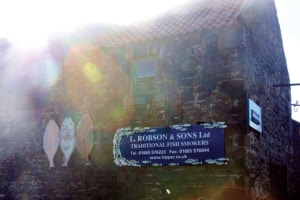
Darkness at noon: Robson’s Kipper Shed Smokehouse in full spate.
As we strolled around the village in the blazing early-season sunshine, we turned a corner and the daylight became obscured. Just then, we laughed as we inhaled the rich aroma of kippers roasting over oak sawdust. This was Robson’s Smokehouse and it was in full swing. This kipper house sells its produce to royalty – and customers all over the world. However, it was still a surprise to see and smell all that smoke in a street! Apparently they serve kippers to eat ‘there and then’ too, but alas we could not try them as we had already eaten twice in Craster that day. Nowadays, no herring are caught from the harbour – they arrive from Scotland by road, which is also good. We were told that these days, the local fishing boats are mostly potting for lobster.
Northumberland Coast Path
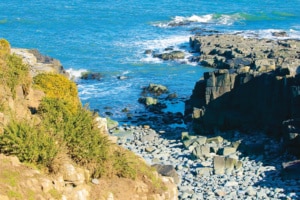
The Northumberland coast is beautiful.
The justly famous Northumberland Coast Path runs right through the village. It offers some of the finest coastal walking in the world, never mind Europe. The path follows this stunningly beautiful but untamed coastline for 62 miles from Cresswell in the south to Berwick-upon-Tweed in the north. Alongside sandy beaches, over rocky headlands, past truly dramatic castles and through attractive coastal villages, the Northumberland Coast Path offers a constantly changing vista. We met two doughty walkers who were taking it easy by traversing the path from country pub to cosy B&B. The views from the path really are epic.
Top tip:
It is well worth logging into the Coast Path website to check for closures due to windblown trees or collapsed footpaths: https://www.northumberlandcoastpath.org/.
Back country
The lonely Northumberland coast has big skies, deserted strands and impressive castles. However, just behind the windy sand dunes and sharp marram grass there is a region of cultivated back country that is small scale, varied and hospitable. The land is up and down, with rocky outcrops, deep woods, neat villages and meandering lanes. It’s properly husbanded ‘hinterland’ that contrasts with the wild coast, but is equally as engaging – definitely worth exploring by local bus, especially if you plan to take on victuals in Alnwick town.
- It’s best to enter Craster directly from the east.
- Local war memorial for Dunstan and Craster.
- That concrete box was the base of an overhead rope railway.
Craster by road
If towing your powerboat, Craster is easy to get to by main road. Follow the A1 north from Newcastle or south from Berwick. Next, turn off the A1 onto the B1340 (near Denwick), and thence down to the village. However, if towing, the last quarter of a mile to the harbour slipway will be congested in summer. It is vital to ring the Craster Harbour authorities well in advance for advice on slipway access and parking your trailer.
Craster by rail
The nearest train station is at Morpeth, approximately 10 miles south on the A1, although there is another at Alnmouth.
The verdict
Craster is tiny and well off the beaten track. Although we would not advise drying out in the harbour, Craster is an engaging top-of-the-tide pause on any Northumberland coastal cruise. It’s also a surprisingly comforting and hospitable place to explore by foot, to dine or just chill out. Truly astounding Dunstanburgh Castle is the icing on the cake.
10 Interesting facts about Craster
- The village is named after the noble Craster family, here since 1272.
- The name Craster is from the Anglo Saxon Craw Caestre, meaning ‘Crow’s Camp’.
- In the past the town has been both a fishing port and a quarry port.
- The harbour was built in 1904 to commemorate a member of the Craster family killed inTibet.
- The town quarry, shut down in 1939, is now the town car park.
- Craster still has a working smokehouse for kippers.
- A kipper is a cured herring, cooked over a fire of oak sawdust.
- The term ‘having a kip’ came from the place where the Scottish kipper women slept.
- The harbour used to have an aerial ropeway to load quarried whinstone onto ships.
- Earl Grey, he of the tea, and prime minister, was born nearby at Howick Hall.
- J.M.W. Turner painted a famous view of Dunstanburgh Castle.
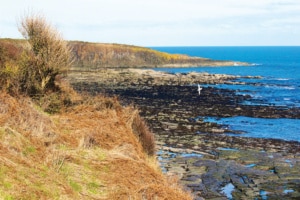
Cruising destinations
Craster is a handy staging post for any trip north to Scotland. Thus a North Sea trip going up the Northumberland coast might include Amble Marina, before passing Alnmouth, depending on the tide, and from there to Craster, via Bamburgh, and then on to Seahouses, before reaching the Farne Islands, including Lindisfarne/Holy Island. Except for Amble Marina, which is full tide, all these other havens dry to sand.
Dunstanburgh Castle
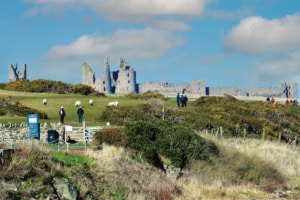 Dunstanburgh Castle dominates its remote rocky headland. It was begun by Earl Thomas of Lancaster in 1313.
Dunstanburgh Castle dominates its remote rocky headland. It was begun by Earl Thomas of Lancaster in 1313.
It is famous for its twin-towered keep, and nowadays for its elegant desolation.
We now know that it was originally built on an even grander scale than we can now see in ruin. It even incorporated a long-lost harbour. Today just a portion of the stone quay survives. Dunstanburgh remains the most extensive castle in Northumberland, a county noted for its magnificent castles.
Many historians consider the castle to be an outward expression of Earl Thomas’s rivalry with King Edward II. Now, rivalling an English medieval king is always a risky business. Earl Thomas’s rebellion was swiftly defeated, and he was executed for his sheer impertinence. For a time, like innumerable British castles, it passed into the hands of none other than John of Gaunt. History does not record John’s feelings about the castle. Next, given its Lancastrian connections, and perhaps inevitably, Dunstanburgh was laid siege in the Wars of the Roses. In fact, it was captured twice by the pernicious Yorkists, who nevertheless still contrived to lose the conflict.
After such momentous times the castle quietly fell into ruin, yielding the truly astounding appearance we behold today. Even now it is rumoured that the castle has tunnels linking it to Craster Tower, in the back country behind Craster Harbour. English artists such as Turner painted the castle, which had long had its place in English folklore. Dunstanburgh Castle has been closely associated with the legend of Sir Guy the Seeker since at least the early 19th century. Different versions of the story vary slightly in their details, but typically involve a knight, Sir Guy, arriving at Dunstanburgh Castle, where he was met by a wizard and led inside. There he came across a noble lady imprisoned inside a crystal tomb and guarded by a sleeping army. The wizard offered Guy a choice of either a sword or a hunting horn to help free the lady. Guy incorrectly chose the horn, which woke the sleeping knights. Sir Guy found himself outside Dunstanburgh Castle, and he spent the rest of his life attempting to find a way back inside. In 1808, English poet Matthew Lewis wrote a noteworthy poem on this legend. Today the castle is in the care of the National Trust.
Harbourmaster
Craster Harbour is privately owned by the Craster family. Mr Alan Robson is the harbour master, and he may be contacted at:
L. Robson and Sons, Haven Hill, Craster, Alnwick, Northumberland NE66 3TR
Tel.: 01665 576223. This is also the number for The Kipper Shed!


